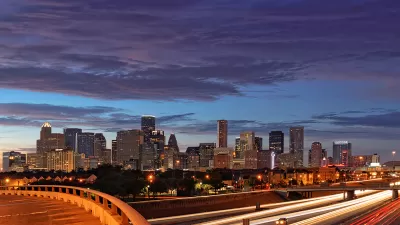A feature in the Houston Chronicle explores the economic segregation of Houston along the axis of Main Street—with low income neighborhoods like Independence Heights to the north and affluent neighborhoods like Old Braeswood to the south.
"Houston is a place of stark contrasts," writes Monica Rohr to frame a feature coverage in the Houston Chronicle. "It is home to pockets of poverty, including Independence Heights, the northside neighborhood where Streets has lived since she was a teenager, and also to multibillion-dollar corporations and multimillion-dollar mansions."
As an example that informs lessons well beyond its municipal boundaries, "[Houston] epitomizes America in 2015, where the gap between rich and poor keeps growing wider and [people live] on just enough to get by, but never enough to get ahead."
The article includes several profiles on citizens trying to overcome the disadvantages of their zip code in neighborhoods that rank among some of the worst in the country on measures like income, college education, and more. The examples of how low income Houstonians struggle illustrate the many manifestations of poverty in urban environments—often found just a few blocks away from affluence and excess.
FULL STORY: The Divide: Income inequality in America's most economically segregated big city

Study: Maui’s Plan to Convert Vacation Rentals to Long-Term Housing Could Cause Nearly $1 Billion Economic Loss
The plan would reduce visitor accommodation by 25,% resulting in 1,900 jobs lost.

North Texas Transit Leaders Tout Benefits of TOD for Growing Region
At a summit focused on transit-oriented development, policymakers discussed how North Texas’ expanded light rail system can serve as a tool for economic growth.

Why Should We Subsidize Public Transportation?
Many public transit agencies face financial stress due to rising costs, declining fare revenue, and declining subsidies. Transit advocates must provide a strong business case for increasing public transit funding.

Dear Tesla Driver: “It’s not You, It’s Him.”
Amidst a booming bumper sticker industry, one writer offers solace to those asking, “Does this car make me look fascist?”

A Visual Celebration of Manhattan’s Chinatown Elder Community, Through Food
Lanterns, cafeteria trays, and community connection take center stage in this stunning photo essay.

How to Make US Trains Faster
Changes to boarding platforms and a switch to electric trains could improve U.S. passenger rail service without the added cost of high-speed rail.
Urban Design for Planners 1: Software Tools
This six-course series explores essential urban design concepts using open source software and equips planners with the tools they need to participate fully in the urban design process.
Planning for Universal Design
Learn the tools for implementing Universal Design in planning regulations.
City of Santa Clarita
Ascent Environmental
Institute for Housing and Urban Development Studies (IHS)
City of Grandview
Harvard GSD Executive Education
Toledo-Lucas County Plan Commissions
Salt Lake City
NYU Wagner Graduate School of Public Service



























